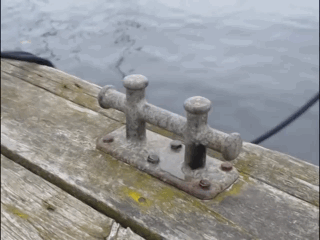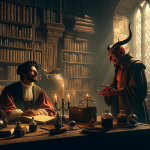After I wrote about seeing Macbeth last week, my mother sent me this excellent video of Sir Ian McKellan unpacking one of the Thane of Cawdor’s speeches, and I figured all y’all might appreciate it as well.
I love it when artisans explain a little about their world, and invite me in to see how it works and to take pleasure in it, too. That’s why I really liked this essay on margins. Yup. Margins.
The movie focuses on a Japanese publishing company’s small dictionary unit. There are only four or five people in it. They are working on a dictionary that will take fifteen years to complete. Fifteen years. The scene that got me was towards the end. The head of the dictionary project meets with the paper maker. They are testing paper.
Hmmm, it doesn’t stick to the fingers enough, says the Dictionary Man as he thumbs the dummy book the Paper Man brought with him.
Oh, is that so? asks the Paper Man.
Yes, look here — perfect dictionary paper sticks to the fingers but doesn’t stick to the other pages. This paper doesn’t adhere properly to my fingers.
The Dictionary Man reaches behind him, grabs another dictionary, and shows the Paper Man a specimen of perfect dictionary usability. It’s exactly the sort of thing you’d never notice unless you lived and breathed dictionaries. Here, you try turning these pages, says the Dictionary Man. The Paper Man does so and responds with an, Oooooooooooooohhh, as if part of the matrix has been unzipped before him. He then apologizes and yells, WE WILL TRY HARDER while bowing deeply.
That’s when I realized my eyes were heating up.
Maybe this was the love part of the story: Two people collaborating on a solution to a problem occupying space often unnoticed but always felt.
I love running into good engineering anywhere. It’s most delightful when there’s a human creator, and I can think about the work and love that went into the creation, but I’ll gladly take some ingenious artifacts of evolution. The New York Times found a whole bunch when they took a look at deep sea biology.
[T]ransparency can complicate life in other ways. Transparent creatures near the surface could be sunburned, not only on the skin but inside, too. To protect themselves from ultraviolet light, “these guys basically have suntan lotion in their transparent tissues,” Dr. Johnsen said.
But that then allows predators with eyes sensitive to ultraviolet light to see them after all. “There’s this evolutionary arms race,” he said. “I call it ‘Fry or die.’ ”
…
A transparent squid also has an opaque gut, because what it eats often is opaque or, worse, glows, which would attract the attention of a larger predator. To minimize its visibility to predators swimming below, the squid’s gut is long and thin, like a needle, and swivels so it points vertically.
The gut itself can have mirrors as supplemental camouflage. Some creatures have evolved ways to defeat the camouflage. Species of squid and shrimp have eyes that can differentiate between the two polarizations of light, something that many insects can do, but which people and most other land creatures cannot do without polarized sunglasses.
The accompanying slideshow, as you might suspect, is pretty awesome.
Still in the nautical world, but human-crafted, the mooring tool used in the gif below confused me so much that I made more than one pass through the slo-mo video at io9, until I could figure out precisely how it worked. Then there may have been a chortle.
Speaking of things best appreciated through slow motion, this video of ballet dancers going through their paces definitely awes/frightens me.
Ballet tends to be a little hard for me to enjoy in real time, in the flesh. I’m just not fluent enough (at present) in the language of ballet to pick up on what is particularly beautiful in the genre or how particular choices should be informing my understanding of plot or characters. So I tend to enjoy videos like the one above or written reviews more than shows, since they highlight aspects of the art for me.
Thus, I also really wound up enjoying Willard Spiegelman’s walk through Caravaggio’s “The Taking of Christ” for The Wall Street Journal. Here’s an excerpt:
Dead center in the picture is the arresting officer, of whose face we can see only a nose and the outline of an upper lip. Otherwise, he is a study in metal. His left arm clasps Christ and his hand extends from the shiny, steel-colored armor of his arm and breastplate. His helmet completes the image. He is all exoskeleton, barely a man at all. The painter has offered an allegory of the way the State—hard, metallic and unyielding—comes to overwhelm compliant, beleaguered, passive humanity. Beside the main officer another, older, soldier reveals more flesh—nose and moustache—but in neither of these figures can we see eyes. In the rear we can make out only the outline of yet one more soldier.
This leaves us with the most mysterious figure of all, neither Roman nor Jew. Dark-headed, handsome, with eyes fully revealed and looking intently at the scene in front of him, this man holds in his right hand a lantern, which offers illumination from behind and to the right of Jesus and Judas. Who is he? The consensus among the experts is that Caravaggio has produced a self-portrait.
And, finally, two different kinds of detailed, difficult work meshing together. This before and after VFX reel for Who Framed Roger Rabbit shows how well Bob Hoskins acted with nothing to work with but a green screen, and how well the animators used what he gave them:
For more Quick Takes, visit Conversion Diary!


















